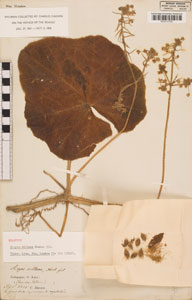'For such facts would undermine the stability of species'
 |
|---|
| Specimen of Sicyos villosa collected in the Galápagos by Darwin and now extinct. |
The Beagle struck west from Lima, finally leaving South America on 7 September 1835. On the long journey home, Darwin began to synthesise all that he had observed and recorded. He postulated a brilliant new theory of the formation of coral reefs even before he saw one for himself in Tahiti. He was also deeply pondering the relationship between varieties and species, and the geographical distribution of plants and animals. Struck by the similarities between fossil and living animals in South America, and by the co-existence of distinct types of the ostrich-like Rhea, he was also fascinated by variant organisms in island populations. One such group was the Thencas – mocking birds – of the Galápagos. After leaving the islands in October 1835, Darwin realised that distinct varieties occupied separate islands in the group – a conclusion he only later applied to the Galápagos finches – and wrote ‘If there is the slightest foundation for these remarks…such facts would undermine the stability of Species.’

